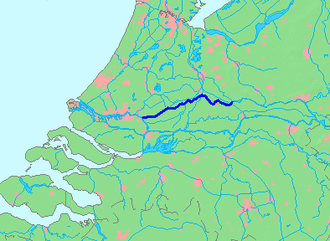| Lek | |
|---|---|
 The Lek River nearNieuwegein. | |
 Location of Lek in dark blue. | |
| Location | |
| Country | Netherlands |
| Region | Utrecht,South Holland |
| Physical characteristics | |
| Source | Nederrijn |
| • location | Wijk bij Duurstede,Utrecht |
| Mouth | Nieuwe Maas |
• location | Kinderdijk,South Holland |
| Length | 62 km (39 mi) |
TheLek (Dutch pronunciation:[lɛk]) is ariver in the westernNetherlands of some 60 km (37 mi) in length.[1] It is the continuation of theNederrijn after theKromme Rijn branches off at the town ofWijk bij Duurstede. The main westboundwaterway is hereafter called the Lek River. The Nederrijn is, itself, adistributary branch of the riverRhine.
Portions of the river form the boundary between the provinces of Utrecht andGelderland, and between Utrecht and South Holland.
In Roman times, the Nederrijn flowed into the Kromme Rijn and these streams were the main outflow of the river Rhine. When the Kromme Rijn began to silt up in the Middle Ages, the Lek became the primary branch. A short distance past Wijk bij Duurstede, the river intersects with theAmsterdam-Rhine Canal, which continues south towards theWaal. A branch of this canal, theLekkanaal (Lek Canal), is connected to the river in the city ofNieuwegein.
Other major towns on its banks areCulemborg,Vianen,Schoonhoven,Nieuw-Lekkerland,Lekkerkerk,Bergambacht, andKrimpen aan de Lek. The bed of the river lies slightly higher than the surrounding lands anddikes are therefore essential to contain the Lek. At the village ofKinderdijk the Lek meets theNoord River and the combined stream is thereafter known as theNieuwe Maas as it flows down towards theNorth Sea.
51°53′25″N4°37′54″E / 51.89034°N 4.63156°E /51.89034; 4.63156